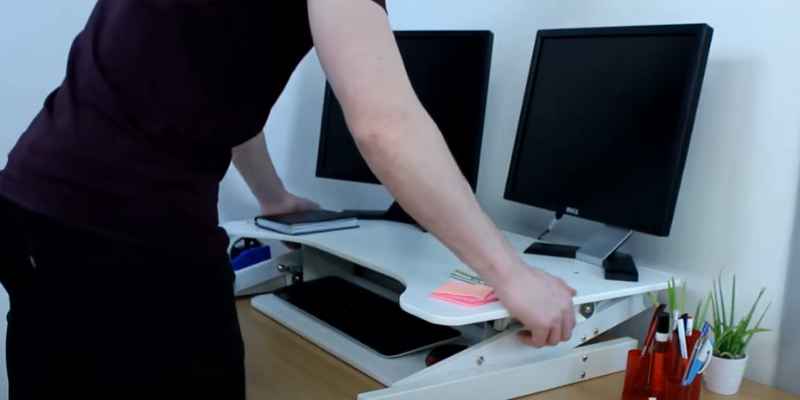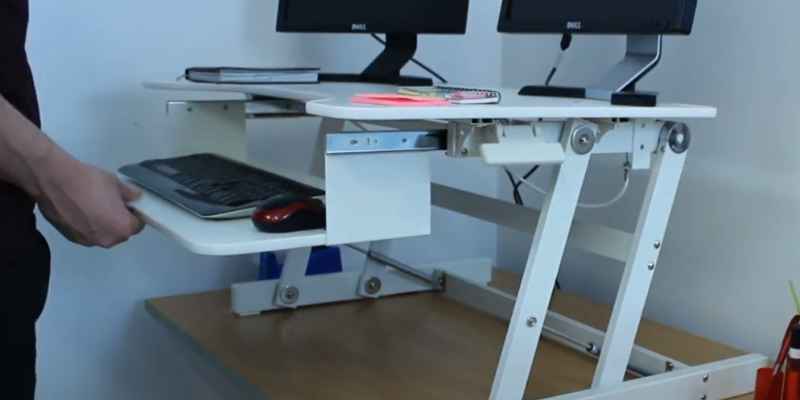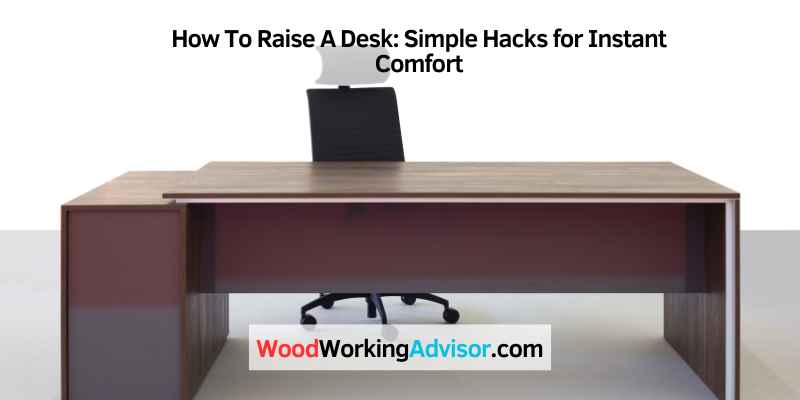To raise a desk, adjust the height using the built-in mechanisms or add adjustable desk legs. Raising a desk to your desired height can provide ergonomic benefits and improve productivity.
Whether you want to switch between sitting and standing positions or simply need a more comfortable working environment, raising your desk can be a simple and effective solution. There are various methods to accomplish this, such as using the adjustable mechanisms already present in the desk or adding adjustable legs.
By following these steps, you can easily raise your desk to a height that suits your needs and preferences. We will explore different techniques and considerations for successfully raising your desk, allowing you to create a more comfortable and productive workspace.
Why Raise Your Desk
Raising your desk can provide numerous benefits, including improved posture, increased productivity, and reduced back pain. Discover how to effortlessly raise your desk and enjoy a more ergonomic work setup.
Health Benefits
Raising your desk can have numerous health benefits. Sitting for long periods has been linked to various health issues, such as obesity, heart disease, and back pain. By raising your desk, you can reduce the time you spend sitting and promote a more active and healthy lifestyle. Standing while working helps to improve blood circulation, engage your muscles, and burn calories. It also helps to relieve pressure on your spine and reduce the risk of developing musculoskeletal problems. In addition, standing can help improve your posture and reduce the strain on your neck and shoulders.
Improved Productivity
Not only does raising your desk have a positive impact on your health, but it can also enhance your productivity. When you stand while working, you tend to feel more energized and focused. Standing encourages better blood flow to the brain, which can improve cognitive function and concentration. By being in an upright position, you are more likely to stay alert and engaged, which can translate into increased efficiency and productivity. Additionally, standing can reduce the likelihood of afternoon slumps and keep you more mentally active throughout the day.
To summarize, raising your desk offers several health benefits, including improved blood circulation, reduced risk of health issues, and increased muscle engagement. It can also lead to improved productivity by enhancing concentration and energy levels. So, why not consider raising your desk and enjoy these advantages for a healthier and more productive work environment?

Determine The Ideal Height
Discover the perfect height for your desk with these simple steps. Raise your desk to the ideal position to create a comfortable and productive work environment.
When it comes to setting up your desk for optimal comfort and productivity, determining the ideal height is essential. Whether you are working from home or in an office, a properly adjusted desk can help prevent strain on your neck, shoulders, and back. Finding the right height for your desk will depend on a few factors, including your height, the type of work you do, and your ergonomic needs.
Ergonomic Considerations
Before you start adjusting your desk, it’s important to consider ergonomic principles. Ergonomics is the science of designing and arranging objects to fit the human body, promoting comfort and efficiency. Working at a desk that is not ergonomically set up can lead to discomfort, fatigue, and even injury.
When determining the ideal height for your desk, keep the following ergonomic considerations in mind:
- Keep your feet flat on the floor or on a footrest.
- Ensure your knees are at a 90-degree angle and parallel to the floor.
- Position your elbows at a 90-degree angle when typing or using your mouse.
- Keep your wrists neutral and avoid excessive bending or twisting.
- Align the top of your monitor at eye level to avoid straining your neck.
Adjustment Options
Now that you understand the importance of ergonomic considerations, it’s time to explore the various adjustment options available for raising your desk to the ideal height. Modern desks often come with height-adjustable features, allowing you to customize the height to your specific needs. Here are a few common adjustment options:
- Manual Crank: Some desks feature a manual crank handle that you can rotate to raise or lower the desk surface.
- Electric Motor: Electric motor-powered desks offer effortless height adjustments at the push of a button.
- Gas Spring: Gas spring desks use compressed gas to assist in raising and lowering the desk, providing smooth and controlled movements.
- Desktop Riser: If you already have a fixed-height desk, a desktop riser can be added to raise your monitor and keyboard to the desired height.
It’s important to choose a desk with adjustment options that suit your needs and budget. Consider how often you will need to change the height and the ease of use for each option. Remember, investing in a desk that promotes proper ergonomics is crucial for your long-term health and productivity.
Desk Raising Hacks
If you’ve ever experienced discomfort while working at a desk that is too low for you, don’t worry, there are solutions available. In this article, we will explore some desk raising hacks that will help you achieve the perfect ergonomic setup for your workspace.
Use Desk Risers
One of the easiest and most effective ways to raise your desk is by using desk risers. These nifty accessories are designed to fit under your desk legs or feet, providing an instant lift. Desk risers can typically be adjusted to different heights, allowing you to customize the elevation according to your needs. They are available in various materials such as metal, wood, or even durable plastic, ensuring sturdiness and stability.
Modify Existing Furniture
Another method to raise your desk is by modifying existing furniture pieces. If you have a sturdy bookshelf or a set of drawers nearby, you can utilize these items to add height to your workspace. By placing your desk on top of the bookshelf or drawers, you can create an elevated surface. To ensure stability, make sure the supports are secure and the surface is level. This hack not only raises your desk but also provides additional storage space for your office supplies.
When using this method, keep in mind that the overall height of your desk should be conducive to a comfortable working posture. Ensure that your elbows are bent at a 90-degree angle when typing, and your monitor is at eye level to reduce strain on your neck and eyes.
DIY Solutions
When it comes to raising a desk, you don’t always need to invest in expensive professional solutions. There are plenty of DIY options available that can help you achieve the desired height for your workspace. In this section, we will explore some creative DIY solutions that can easily be implemented without breaking the bank.
Stacking Books Or Blocks
If you’re looking for a quick and cost-effective way to raise your desk, stacking books or sturdy blocks is a simple yet effective solution. All you need to do is gather a few books or blocks of the same height and place them strategically under the desk legs. This method allows you to customize the height by adding or removing books or blocks as needed.
Adjustable Desk Legs
If you prefer a more versatile option, adjustable desk legs are a great choice. These legs can be easily attached to your existing desk and provide the flexibility to adjust the height according to your preference. Whether you need to make small tweaks or significant changes, adjustable desk legs offer you the convenience to adapt your workspace to your needs.
Not only are these DIY solutions budget-friendly, but they also give you the freedom to customize the height of your desk to ensure optimal comfort and productivity. Take advantage of these simple yet effective methods to raise your desk and create a workspace that suits your needs.

Preventing Desk Wobbling
Having a stable workspace is crucial for comfortable and productive work sessions. An unstable desk can be bothersome, causing distractions, discomfort, and even safety hazards. Fortunately, there are effective techniques and tips to stabilize your desk and prevent wobbling. In this post, we will explore some stabilizing techniques and the importance of choosing stable furniture for your desk setup.
Stabilizing Techniques
Here are a few tried-and-true techniques to stabilize your desk and eliminate wobbling:
- Adjust the feet: Ensure that all the feet of your desk are in full contact with the floor. If any feet are uneven, use adjustable pads or shims to level them. This will distribute the weight evenly, reducing wobbling.
- Tighten the screws: Check all screws and bolts connecting different parts of your desk. Over time, they may loosen, leading to instabilities. Use a screwdriver or wrench to tighten them securely and regain stability.
- Add supportive crossbars: Some desks come with crossbars that connect the legs, adding stability. If your desk doesn’t have them, consider installing additional crossbars. These can reinforce the structure, minimizing wobbling.
- Use adhesive bumpers: Apply adhesive bumpers or pads to the bottom of your desk legs. These act as cushioning buffers between the desk and the floor, reducing vibrations and wobbling.
- Consider using a desk stabilizer: Desk stabilizers are accessories specifically designed to eliminate desk wobbling. These are typically adjustable and can be securely attached to the bottom of your desk, ensuring stability across all four corners.
Choosing Stable Furniture
Investing in stable furniture from the beginning can save you from future desk wobbling issues. When selecting a desk, keep the following factors in mind:
- Material: Opt for desks made from sturdy materials such as solid wood or metal. These materials offer better support and durability, reducing the chances of wobbling.
- Construction: Check the construction of the desk to ensure it is solid and well-built. A desk with reinforced joints and sturdy connections will be less prone to wobbling.
- Leg design: Consider desks with wide and stable legs. Tapered or angled legs may look sleek, but they are more likely to wobble. Straight legs or those with reinforcement are preferable for stability.
- Weight capacity: Make sure the desk you choose can comfortably support the weight of your equipment and supplies. Overloading a desk beyond its capacity can lead to wobbling and strain on the structure.
- User reviews: Before purchasing a desk, check user reviews to see if stability is a common concern. Honest feedback from others who have already experienced the desk can help you make an informed decision.
By utilizing these stabilizing techniques and selecting stable furniture, you can create a sturdy and wobble-free workspace. Remember that a stable desk promotes better focus, improved productivity, and ensures a comfortable working environment.
Conclusion
Raising your desk has never been easier! With just a few simple steps, you’ll be able to customize your workspace to meet your ergonomic needs. By following the tips and techniques outlined in this blog post, you can improve your posture, increase productivity, and reduce the risk of common desk-related ailments.
So don’t wait any longer, give your desk the lift it deserves and experience the benefits for yourself!


